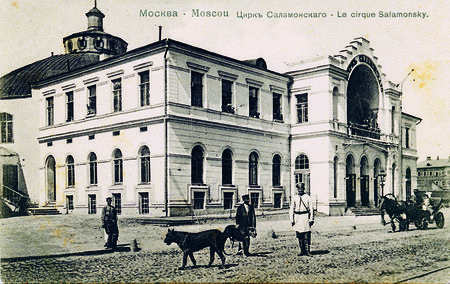Main Page
From Circopedia
|
In The Spotlight
THE CIRCUS ON TSVETNOY BOULEVARD
Circus buildings with a long history have something magical. They seem haunted by the protective ghosts of the great star performers who, over the years, have graced their ring. The world’s oldest extant circus building, Paris’s Cirque d’Hiver, where Jules Léotard originated the flying trapezeAerial act in which an acrobat is propelled from a trapeze to a catcher, or to another trapeze. (See also: Short-distance Flying Trapeze) in 1859, is one of them. The glorious Circus Ciniselli in St. Petersburg, Russia’s oldest circus, is another one. And in Moscow, there is Circus Nikulin—"the Old Circus on Tsvetnoy Boulevard."
The Circus on Tsvetnoy Boulevard: Three distinct circus buildings, actually, have been known under that name. The three buildings have occupied the exact same place, 13 Tsvetnoy Boulevard, with no longer interruption than the time needed for their reconstruction. Yet, for the Muscovites, they have been one and the same—their circus, just wearing different coats.
Before the Soviet revolution, Russian circus history was principally written in St. Petersburg, the Russian Empire’s capital, and began when the French equestrian Jacques Tourniaire built the Cirque Olympique, Russia’s first circus, in 1827 near the Fontanka canal, on the spot where Circus Ciniselli (which is extant) would be erected half a century later. Tourniaire had performed in Moscow in 1826, but this was in the private manège of the Pashkov House, which today houses the Russian State Library—with its magnificent manège refurbished as its main reading room.
Moscow’s first circus was a wooden structure erected in the Niskuchnye Gardens in 1830, which lasted three summer seasons. The second circus, Laura Bassin’s, was built in 1853 and lasted only two seasons. The third was the circus the Austrian-Hungarian equestrian Carl Magnus Hinné had built in 1869 as the Moscow branch of his St. Petersburg flagship circus; it would remain active, under various managements, until 1896. Then, in 1880, Albert Salamonsky (1839-1913), a brilliant German equestrian and director, built a brand new circus on Tsvetnoy Boulevard.
Hinné had hired Salamonsky in 1869 to perform with his horses and his company in the Austrian-Hungarian director’s new building in Moscow. Salamonsky, who was an accomplished high schoolA display of equestrian dressage by a rider mounting a horse and leading it into classic moves and steps. (From the French: Haute école) rider, and an outstanding trainer of "liberty"Liberty act", "Horses at liberty": Unmounted horses presented from the center of the ring by an equestrian directing his charges with his voice, body movements, and signals from a ''chambrière'' (French), or long whip." acts, had obtained a considerable success with Hinné, and he began afterward to tour regularly in Russia. In 1879, he built a circus in Odessa, but a shrewd businessman, he knew that the place to make real money was Moscow—the Empire’s wealthy merchant center—where Hinné’s circus, which was mostly harboring foreign touring companies, had no true identity of its own..... (more...)
New Essays and Biographies
- Alessandro Guerra, Equestrian, Circus Director
- Jimmy Scott, Clown
- Alexis Gruss, Jr., Equestrian, Circus Owner
- Alona Zhuravel, Hand-Balancer
- George Carl, Clown
New Videos
- Caitlin & Spencer, Aerial Hoop (2022)
- Brihanna & Miranda Giménez, Washington Trapeze (2023)
- Julot Cousins, swaypoleA high, flexible vertical pole (originally made of a single piece of wood, and today of fiberglass) atop of which an acrobat performs various balancing tricks. (2023)
- Olga & Marat Devlikamov, Chinese Pole (2023)
- Wesley Williams, unicycle (2020)
New Oral Histories
- For A Moment You Fly, The First Season of The Big Apple Circus (1977)
- Vladimir Durov Documentary on Russian Television (c.2000)
- Dolly Jacobs Interview at The Ringling (2018)
- Pinito del Oro's Interview on Spanish Television (1970)
- Gia Eradze's Interview on SSU TV (2015)
Circopedia Books
- Philip Astley & The Horsemen who invented the Circus, by Dominique Jando (2018)
A Message from the Founder
CIRCOPEDIA is a constantly evolving and expanding archive of the international circus. New videos, biographies, essays, and documents are added to the site on a weekly—and sometimes daily—basis. Keep visiting us: even if today you don't find what you're looking for, it may well be here tomorrow! And if you are a serious circus scholar and spot a factual or historical inaccuracy, do not hesitate to contact us: we will definitely consider your remarks and suggestions.
- Dominique Jando
- Founder and Curator
